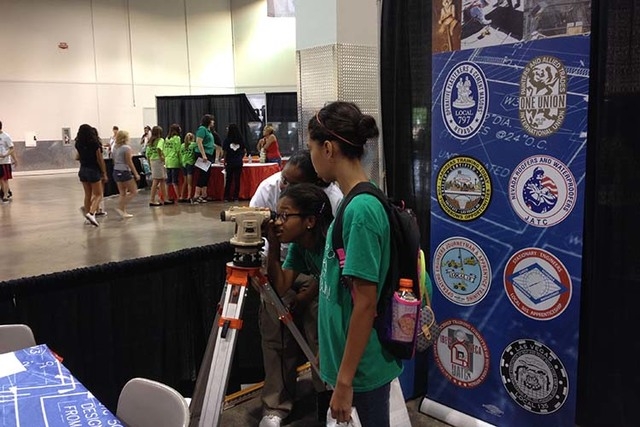Survey shows discrimination, harassment against women in construction
Working with her hands and having the ability to create, Jovan Johnson fell in love with carpentry and decided to enter the construction industry about a decade ago.
“I realized early on I enjoyed it, and I was good at it,” she says. “There is just something really rewarding about seeing what you can accomplish.”
Though Johnson says she has proven herself time and time again on any job she has secured, she still is fighting an industry that caters to men.
According to a report released in June by the National Women’s Law Center, women in the construction industry still face sexual harassment, gender stereotypes and lack of opportunity in the industry.
The study, “Women in Construction: Still Breaking Ground,” says that women make up 2.6 percent of the industry in America.
In the United States, while there are about 7.6 million men in construction jobs there are only 206,000 women in the industry, the report says.
Among construction occupations, women make up 4.5 percent of construction laborers, 1 percent of carpenters and 1.5 percent of supervisors.
The numbers are even more dismal for women of color, the report suggests. Although white women make up 2 percent of construction workers, Hispanic women are 0.4 percent, African-American women are 0.2 percent, and Asian, Pacific Islander and American Indian are 0.1 percent.
“That number has pretty much stayed the same over the last three decades,” says Neena Chaudhry, the senior counsel at the National Women’s Law Center who authored the study. “Sure, the economy has had an effect on jobs, but these numbers have been low for decades.”
Chaudhry says it’s a little surprising this hasn’t changed in years, especially considering about 35 years ago the federal government created diversity goals in the industry.
She adds that lack of access can have adverse economic effects on women considering the median hourly wage for construction work is $19.55, which is double the median hourly wage for female-dominated occupations such as child care workers.
Also, women also face discrimination, Chaudhry says.
According to the U.S. Department of Labor, 88 percent of women construction workers reported experiencing sexual harassment on the job in 2013.
Johnson moved to Las Vegas in 2004 to become a carpenter and learned early on she’d face struggles trying to prove herself at work.
“The men you work with think you’re not going to keep up, or you’re not willing to learn,” she says. “You have to have a good attitude and prove them wrong. You got to show them you’re willing to work hard.”
Johnson says going into new jobs, men would make assumptions about her.
“It was funny,” she says. “They had never worked with me before, or didn’t know about my past work. Yet, they would assume I wouldn’t be a hard worker.”
Many of the jobs, it was even the first time guys had worked with women.
“On Monday, they wouldn’t want to work with me but by Wednesday, they were fine working with me,” she adds. “They knew I was hard-working.”
Being African-American, she also faced racial stereotypes, too.
“I had one guy assume I ‘didn’t know how to speak proper English,’ ” she recalls. “Then he asked me, ‘Are you really black?’ ”
As far as accountability to hold employers culpable for discrimination, Johnson says it depends on the company.
Heidi Zupancic, vice president of the Nevada chapter of the National Association of Women in Construction, says though there has been improvement, the industry is still very much a boys club.
Zupancic says in her experience, if a woman is upset about a project not getting done, she is overly emotional. However, if a man is angry for similar reasons, he is just a hard-working, passionate employee.
“They will say things like, she’s on the rag or it must be her time of the month,” she says. “Women have to fight those misconceptions constantly. You have to take it in stride.”
Zupancic adds that part of the low numbers of women in construction has to do with a slowed economy.
Many women had to exit the industry after the economy soured in 2008 and construction jobs became virtually nonexistent, she notes.
“I knew work was going to slow down,” Zupancic says. “I didn’t expect it to drop.”
Some women, she says, left the city, venturing around the globe to find work.
“I was offered a position in Abu Dhabi (United Arab Emirates),” she adds. “I was not ready to pack my bags. It wasn’t for me. Others took jobs in the Middle East and have had success.”
On top of already high competition for work, Zupancic says men were favored over women for the few positions that became available.
“A lot of women had to revamp themselves and choose a different industry,” she says.
Johnson remains determined to stay a carpenter.
She has been looking for a permanent job for the past two years.
“I have done short-term projects,” she says. “I always try to keep busy volunteering, too. Even though I’m unemployed, I always stay up-to-date on trades and tools in the industry.”
She says she still faces barriers in being hired because of her gender.
“You’d have men who were the same height and size as you, but they were always chosen first,” she says.
She adds it was made worse if foremen had bad experiences with other women on the job.
Organizations such as the Nevada chapter of the National Association of Women in Construction and the Southwest Carpenters Training Fund work to help women entering the industry.
Debbie Mello, a sales coordinator with Desert Lumber and the chapter president for the National Association for Women in Lumber, says the organization is for women in construction to gather and discuss the issues within the industry.
It also educates students about the viability of entering the workforce.
“You can get a good-paying job in construction,” she says.
At its height, there were more than 100 members in the organization.
It’s now at 60.
“We are getting back there,” Zupancic says.
Zupancic and Mello have both been in the industry long enough to know firsthand the obstacles many women face.
“I understand the feeling of walking out in the yard and being the only female,” Mello says. “It can be an uncomfortable feeling.”
She entered the industry working at a lumber mill in 1981 after serving in the military.
Even though she had faced gender stereotypes in the military, she didn’t expect to encounter the same sentiment in the construction industry.
“I was a little surprised,” she says. “It just shows how people are brought up or their lack of education.”
Being female, co-workers would always try to do her job or ask her if she needed help.
Realizing she didn’t want to spend the rest of her life on the manual side, she decided to go to school for business management to work in sales for construction companies.
“You have the same mindset in there, too,” she says. “They think because you’re a girl, you didn’t know what you were talking about, or I didn’t know about lumber. But I worked from the ground up. I was experienced.”
Within the report, Chaudhry says there are several recommendations the industry could institute to promote change.
For example, the Office of Federal Contract Compliance Programs could strengthen its oversight of contractors and the requirements to increase access for women in construction.
The report also recommends the Labor Department’s Apprenticeship Office revise its affirmative action regulations to increase the numbers of women and minorities in these programs.
“But these barriers start back in school,” Chaudhry says.
Donald Hayes, chairman of UNLV’s civil and environmental engineering and construction management department, hadn’t heard about the study.
“I am disappointed to hear that gender discrimination is a problem in the industry,” he says.
Hayes says that in the past two years there have been 15 graduates who received a bachelor’s in construction management, two of them were female.
Overall in civil engineering, there has been 84 graduates since 2013, 21 who were female.
Hayes says while in the program, there is a zero tolerance policy against any type of discrimination.
“We spend a lot of time talking about professionalism and ethics, including the fact that any sort of discrimination is unacceptable,” Hayes adds. “We do not isolate gender discrimination specifically.”
Though there aren’t mentorship programs at UNLV catering specifically to women, Hayes says employers are often eager to hire women and minorities.
The National Association for Women in Construction and the Southwest Carpenters Training Fund have worked with women like Johnson to help them gain apprenticeships.
Zupancic says the organization is trying to connect with UNLV to make sure women who want to enter the field have the resources to do so starting at a college level.
Johnson says one way to turn this industry around is to encourage more women to join.
“It’s an uphill battle but one we can win,” Johnson says. “Every time a worker goes in and proves them wrong, we win.”
Contact reporter Michael Lyle at mlyle@reviewjournal.com or 702-387-5201. Follow @mjlyle on Twitter.






























